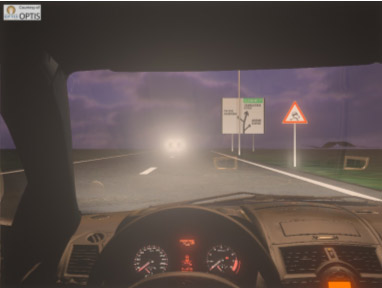OPTIS announces the launch of brand new solution for Windshield Analysis, designed to allow both windshield manufacturers and vehicle manufacturers to check the compatibility of their windshield design with optical standards, to make a static analysis of image distortion through the windshield, and to make video sequences of what will be seen through it while the vehicle is in motion, thus enabling them to validate the windshield’s visual performance.
It is aimed at vehicles manufacturers who wish to validate a new shape of windshield, and to those windshield manufacturers wishing to make a complete analysis of their design. This software is available in both SPEOS standalone which is compatible with all CAD programs, and it is also integrated in CATIA V5 from Dassault Systèmes.
SPEOS Windshield Analysis will not only answer the needs of windshield manufacturers themselves but also those of several departments within vehicle companies. By sharing this solution the vehicle-manufacturer departments working on style, body, life on board, and safety will benefit from being able to share data about designs more easily, and check them right from the first stages of the development process. The user will be able to quickly evaluate the impact of the modifications he or she makes to the design and adjust it accordingly.

The vehicle manufacturer can now check the design without having to transfer it to the windshield manufacturer, maintaining confidentiality for as long as possible while saving time and money. Given the problem of one being able to determine the design of a new vehicle from a windshield design, this advantage has already proved popular with vehicle manufacturers.
SPEOS Windshield Analysis is an efficient engineering tool for windshield manufacturers and, thanks to its easily interpreted graphic results, Windshield Analysis will help them to explain and justify their designs to car manufacturers quickly. Windshield manufacturers will be able to produce a feasibility study within one hour of receiving the project.
Windshield Analysis has already been chosen by a major windshield manufacturer. Using this solution means they will be able to cut out the phase of real tests traditionally conducted in a laboratory, and thus reduce the time it takes to design and determine the final shape. In turn this will help to reduce the lead times for launching a new vehicle.
This newly developed solution enables the user to check that the windshield design complies with the international standards ECE R43 and SAE Z26. The user will also be able to carry out a quantitative analysis of the windshield in terms of distortion, light transmission, secondary image and color identification. On top of this, Windshield Analysis Workbench enables a qualitative evaluation of the windshield for the vehicle in both static and dynamic conditions.
One of the innovations of this solution is the particular attention paid to optical surfaces, whose specific shape must be accurately modeled in the mechanical environment.
Distortion in the dynamic state can be easily calculated, a useful plus given that the human eye will see “image acceleration” on the edge of a windshield in a moving vehicle but will not see it when the vehicle is stationary. “Image acceleration” is of interest to car manufacturers and is a criterion that should be taken into account along with standards compliance when choosing a windscreen design.
With SPEOS Windshield Analysis, the windshield designer will be able to simulate the sighting target for reflection and transmission, view sighting marks, and also model how those marks distort the image (the road, landscape) through the windshield. The Moiré effect can also be simulated for analysis of distortion – something that until now could only be observed empirically on a physical prototype.
Non-specialists will quickly master it the Windshield Analysis solution, which does not require any optical or technical knowledge. Users can simply select the windshield geometry in their CAD program, and the workbench will do the rest, giving optically accurate results in a matter of minutes about its compliance with standards.
“With SPEOS Windshield Analysis, OPTIS is launching on the market a solution which will interest vehicle and windshield manufacturers alike,” said Jacques DELACOUR, CEO of Company OPTIS. “Thanks to this unique, dedicated software, car manufacturers will have greater control over windshield design, and windshield manufacturers will be able to respond to car makers’ requests quicker and more accurately.”
"This new OPTIS application demonstrates the power of a virtual optical simulation solution delivered in an integrated PLM environment," said Severin LANFRANCHI, director of research and development, Dassault Systèmes. "This solution lets users conform to industry standards in the course of virtual product development. Furthermore, the added value of being able to create simulations will enable our automotive clients to reduce costs and to be able to optimize the final design of a windshield very early in the product development process."
EDS Technologies (EDST) is the strategic business partner of OPTIS in India. With its vast experience in light simulation spectrum, EDST offers value added solutions and services to Auto Industry and wind shield manufacturers. Contact marketing@edstechnologies.com for more details.
|
